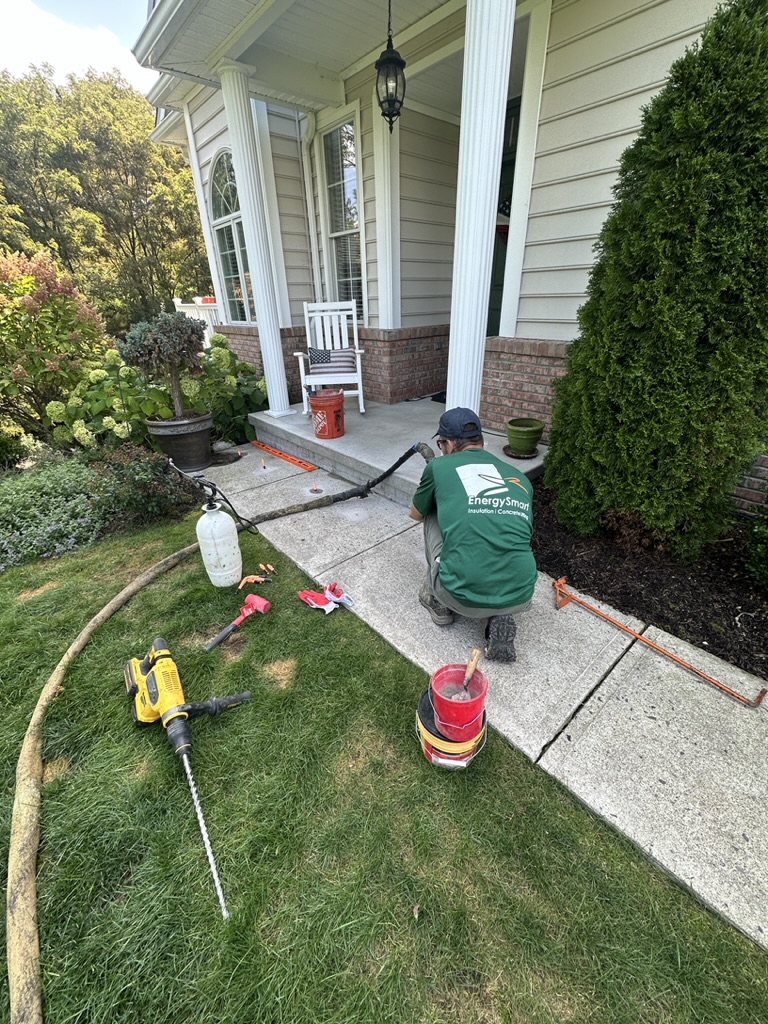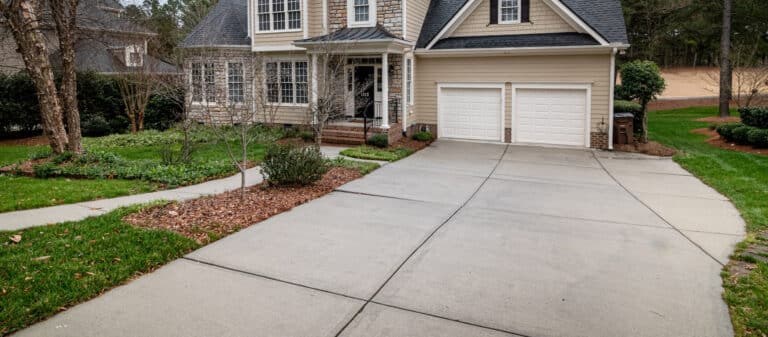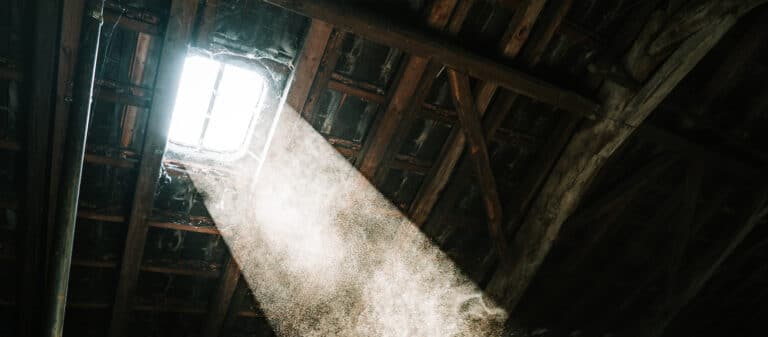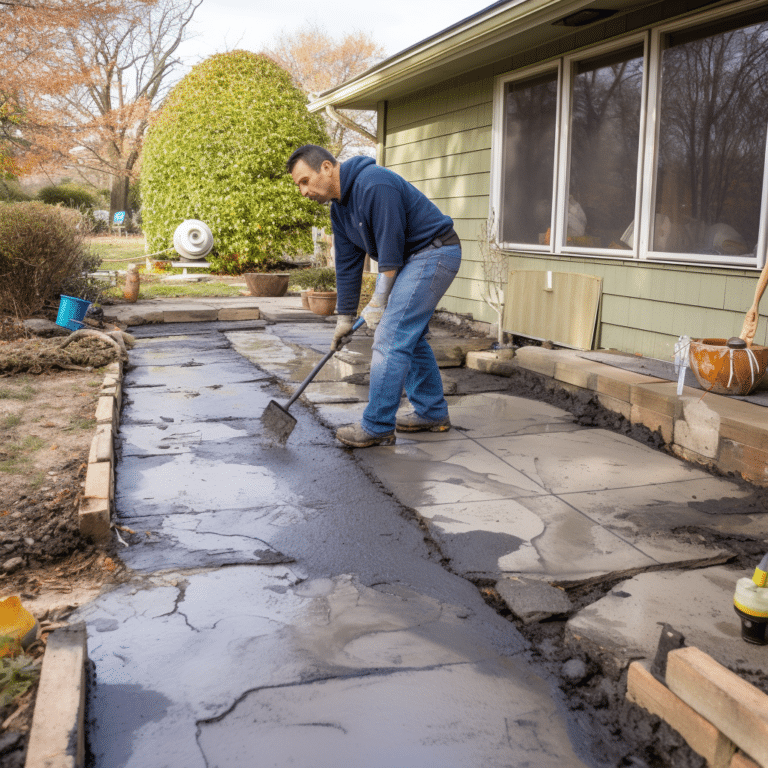Concrete settlement can be a dangerous and frustrating issue for many Pennsylvania homeowners. Not only can sunken concrete be a tripping hazard, but it could also prevent water from properly flowing away from your home and further damage your foundation.
Of all the things homeowners budget for in Northeast PA, their concrete sidewalks, driveway, or foundation may not be one of them.
Polyjacking is considered the most cost-effective and long-term solution to concrete settlement, but, depending on the situation, you’re still looking at hundreds of dollars in repair. You could save money by polyjacking your concrete yourself, but is it really doable or safe?
Find out as we explore different options to raise concrete yourself using polyurethane foam and when to call the professionals.
What is Polyjacking?
Compared to mudjacking or concrete replacement, polyjacking is the most efficient and least intrusive method to raise concrete.
Polyjacking raises concrete slabs by injecting a high-density polyurethane foam beneath the sunken concrete slab, where a technician slowly raises it until achieving the desired level.
The polyurethane foam is designed to expand to fill voids beneath the slab where settlement might have occurred, allowing the foam to support the slab for as long as the mixture holds up.
Polyurethane foam lasts for decades, is moisture resistant, and only needs to be installed by drilling two penny-sized holes.
Benefits of Polyjacking
- Speed: Polyjacking foam cures quickly, often within 15 to 30 minutes, allowing for immediate use of the concrete surface.
- Less Invasive: The injection process involves drilling only small, penny-sized holes into the slab, minimizing damage and cleanup.
- Durability: Polyurethane foam is resistant to moisture, so it’s less likely to wash out over time compared to mudjacking mixtures.
- Precision: The polyjacking process allows technicians to slowly raise the slab, giving them greater control over the final result.
- Lightweight Material: Since the foam is lighter than traditional mud or cement, there is less risk of further soil compaction, which can lead to additional settling.
Can You Polyjack Concrete Yourself?
While polyjacking is often performed by professionals due to the specialized equipment and expertise required, you can technically rent the equipment and do it yourself. So the question becomes should you raise concrete by yourself using polyjacking equipment?
To determine this, let’s first break down the process and equipment you need to get started.
The Polyjacking Process
Polyjacking involves several key steps, which require expertise and specialized tools to complete:
- Assessment: You will need to evaluate the areas where the concrete has sunk the soil conditions underneath to see if it’s the result of void formation.
- Drilling Holes: Once identified, two to three small holes (around 5/8-inch diameter) will be drilled into the concrete slab to allow for foam injection.
- Injecting Polyurethane Foam: The foam will be injected using a specialized machine with a hose.
- Sealing: Once the slab is raised in certain areas to create a level appearance, the holes will be patched and sealed to match the surrounding concrete.
Required Tools and Equipment
Some of the equipment needed for polyjacking includes:
- A polyurethane foam injection system (consisting of pumps, hoses, and nozzles)
- Drills and bits for creating holes in the concrete
- Protective gear (gloves, goggles, etc.)
- Patch materials for sealing the injection holes
Polyurethane foam kits are available at hardware stores or online. However, they can be expensive (totaling hundreds of dollars.
Dangers of Polyjacking Concrete Yourself
While the process of polyjacking concrete by yourself is not terribly complicated, you could end up doing more damage if the process is not performed correctly.
- Uneven Lifting: Raising part of the slab too much or too little can result in an uneven slab, essentially wasting your money in the process.
- Material Waste: Polyurethane foam expands rapidly, and improper handling can result in overuse or waste of costly materials.
- Damage to the Slab: Incorrectly drilling or injecting foam can cause cracks or additional stress to the concrete that may require replacement or patching.
- Injury Risk: Handling heavy slabs and equipment without proper precautions increases the risk of accidents or personal injury.
Factors When Choosing Between DIY and Professional Polyjacking
When comparing the costs and risks of DIY polyjacking with professional services, it makes sense for most homeowners to trust a local contractor. Let’s examine some factors when deciding between DIY and professional polyjacking.
- Return on Investment: When added up, the cost to rent equipment and perform the labor yourself may only save you a marginal amount of money when compared to the cost of working with a local contractor. However, this does not factor in the time lost performing that labor or even the wear and tear you might experience working with such heavy equipment.
- Skill Level: While polyjacking is less messy than mudjacking, it still requires precision and a good understanding of concrete lifting. Improper foam injection can cause the slab to lift unevenly or even crack, resulting in more financial headaches than anticipated.
- Safety Concerns: Lifting heavy slabs of concrete involves some inherent risks. Without proper precautions, accidents or injuries during the lifting process may be costly.
When to Call a Contractor for Polyjacking
We recommend working with a qualified contractor in almost all instances where concrete needs to be raised and leveled. While smaller projects, such as lifting a sidewalk, may be performed DIY, the risks far outweigh the benefits, not to mention the amount of time and energy you’ll need to educate yourself, rent the equipment, and perform the labor.
EnergySmart provides fast and affordable polyjacking solutions to Pennsylvania residents that guarantee results and save them money. For more information on how we can help you raise your concrete, contact us today for a free quote.
FAQs
How long does polyjacking last?
Polyjacking is a long-term solution. The foam used in the process is durable and resistant to moisture, making it a reliable fix that can last for decades.
Is polyjacking better than mudjacking?
Yes. Polyjacking is less invasive, more precise, and the foam is lightweight, reducing the likelihood of further sinking. However, it can be more expensive than mudjacking, though mudjacking only lasts between 3-5 years.
Can polyjacking be used for all types of concrete?
Polyjacking works well for most outdoor slabs, including driveways, patios, and sidewalks. It’s not typically used for vertical surfaces or structural elements.











